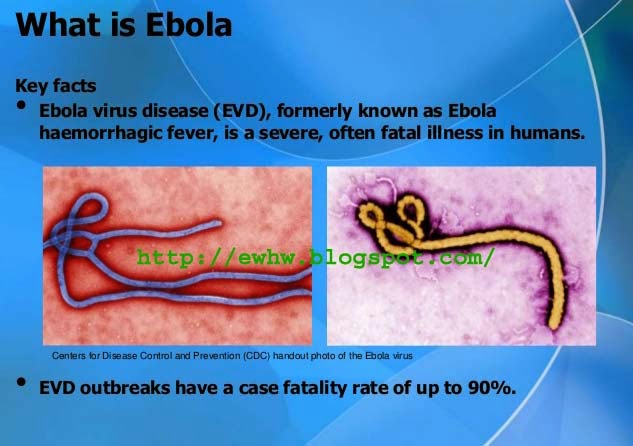What is Ebola Virus Disease
Ebola virus disease, previously known as Ebola hemorrhagic fever (EVD; also Ebola hemorrhagic fever, or EHF), or simply Ebola, is a rare and deadly disease caused by infection with one of the Ebola virus strains. It is a disease of humans and other primates (monkeys, gorillas, and chimpanzees) caused by ebola viruses.Ebola is caused by infection with a virus of the family Filoviridae, genus Ebolavirus. There are five identified Ebola virus species, four of which are known to cause disease in humans: Ebola virus (Zaire ebolavirus); Sudan virus (Sudan ebolavirus); Taï Forest virus (Taï Forest ebolavirus, formerly Côte d’Ivoire ebolavirus); and Bundibugyo virus (Bundibugyo ebolavirus). The fifth, Reston virus (Reston ebolavirus), has caused disease in nonhuman primates, but not in humans.
Ebola viruses are found in several African countries.
The disease was first discovered in 1976 in two simultaneous outbreaks, one in Nzara, and the other in Yambuku, a village near the Ebola River from which the disease takes its name. EVD outbreaks occur intermittently in tropical regions of sub-Saharan Africa. Between 1976 and 2013, the World Health Organization reports a total of 24 outbreaks involving 1,716 cases. As of February 2015 the largest outbreak is ongoing, the epidemic in West Africa centered in Guinea, Sierra Leone and Liberia. As of 3 February 2015, this outbreak has 22,560 reported cases resulting in 9,019 deaths.
Why Ebola Virus Disease
The natural reservoir host of Ebola virus remains unknown. However, on the basis of evidence and the nature of similar viruses, researchers believe that the virus is animal-borne and that bats are the most likely reservoir. Four of the five virus strains occur in an animal host native to Africa.How Ebola Hemorrhagic Fever
The virus spreads by direct contact with body fluids, such as blood, of an infected human or other animals. This may also occur through contact with an item recently contaminated with bodily fluids. Spread of the disease through the air between primates, including humans, has not been documented in either laboratory or natural conditions. Semen or breast milk of a person after recovery from EVD may still carry the virus for several weeks to months. Fruit bats are believed to be the normal carrier in nature, able to spread the virus without being affected by it. Other diseases such as malaria, cholera, typhoid fever, meningitis and other viral hemorrhagic fevers may resemble EVD. Blood samples are tested for viral RNA, viral antibodies or for the virus itself to confirm the diagnosisSigns and symptoms of Ebola Hemorrhagic Fever
The length of time between exposure to the virus and the development of symptoms (incubation period) is between 2 to 21 days, usually between 4 to 10 days. However, recent estimates based on mathematical models predict that around 5% of cases may take greater than 21 days to develop.Symptoms from 7 to 9 days
1. Symptoms usually begin with a sudden influenza-like stage characterized by feeling tired, fever, weakness, decreased appetite, muscle pain, joint pain, headache, and sore throat.2. The fever is usually higher than 38.3 °C (100.9 °F).
3. In some cases, between five to seven days after first symptoms, internal and external bleeding may occur.
4. In about half of the cases, the skin may develop a maculopapular rash, a flat red area covered with small bumps, 5 to 7 days after symptoms begin.
Symptoms from 10th day
1. Vomiting, Diarrhea and abdominal pain may occur.2. Shortness of breath an chest pain may occur, along with swelling, headaches and confusion.
3. All infected people show some decreased blood clotting. Bleeding from mucous membranes or from sites of needle punctures has been reported in 40–50 percent of cases.
4. This may cause vomiting blood, coughing up of blood, or blood in stool.
Symptoms from 11th day
1. Bleeding into the skin may create petechiae, purpura, ecchymoses or hematomas (especially around needle injection sites).2. Bleeding into the whites of the eyes may also occur.















No comments:
Post a Comment